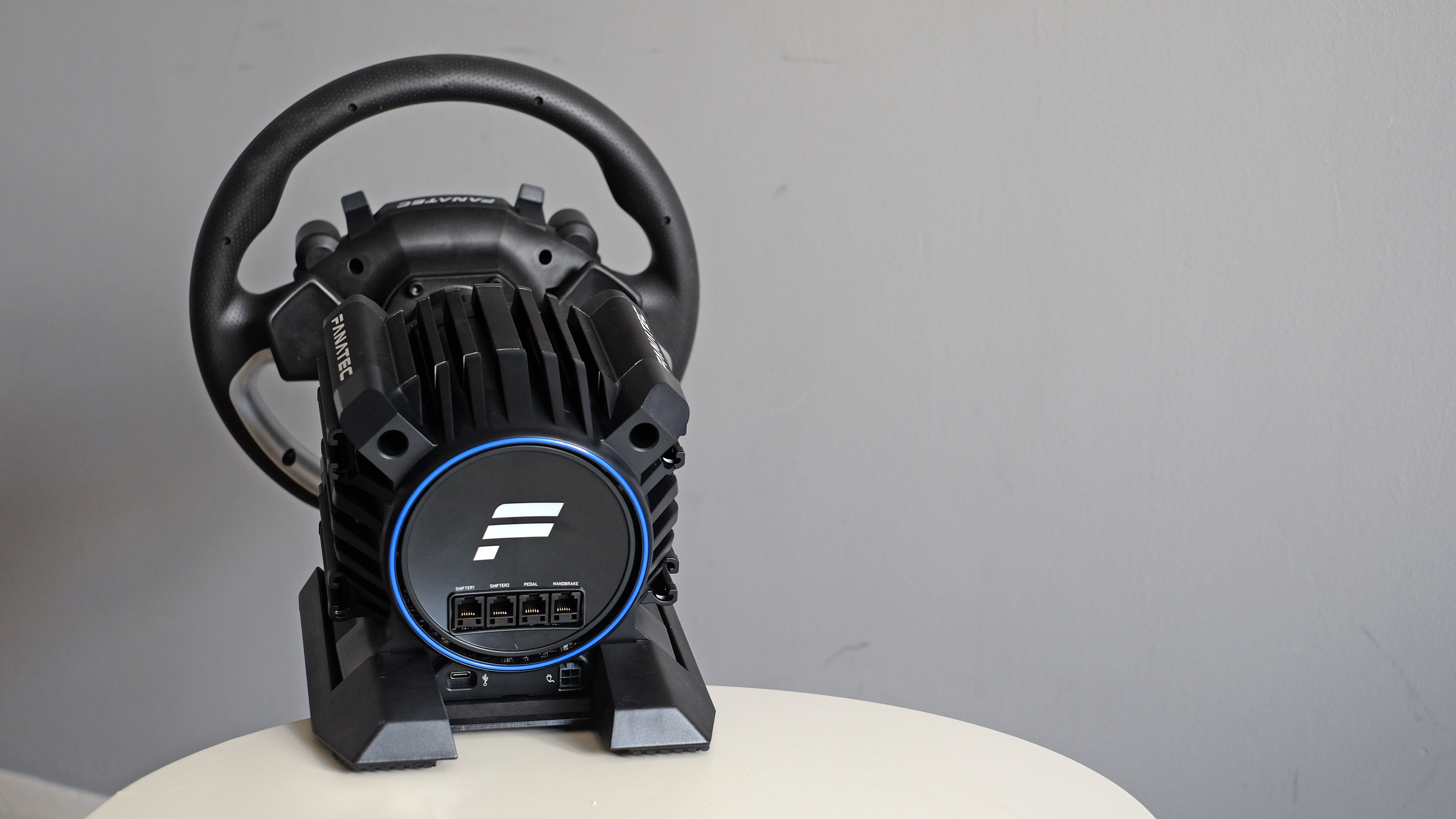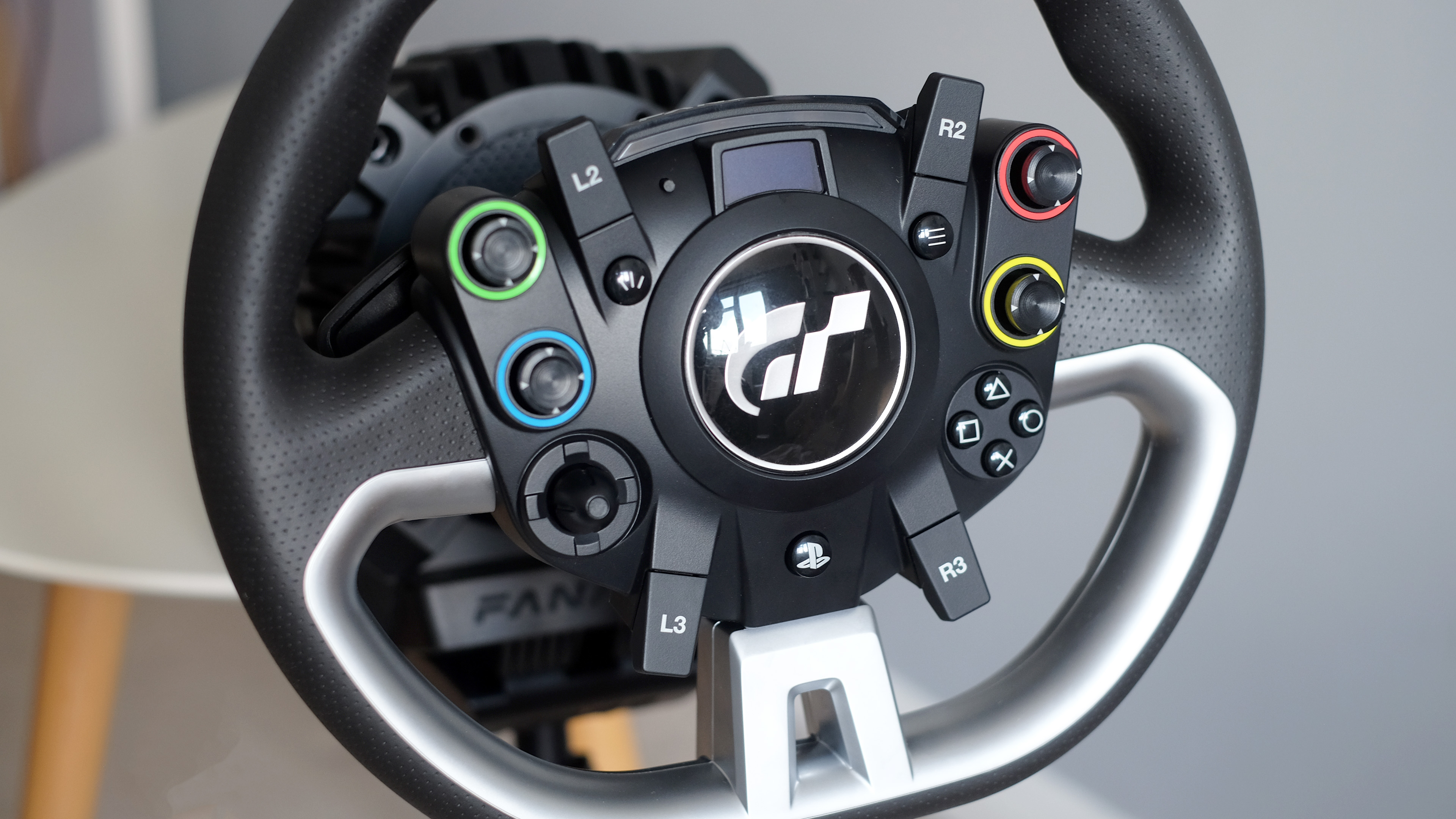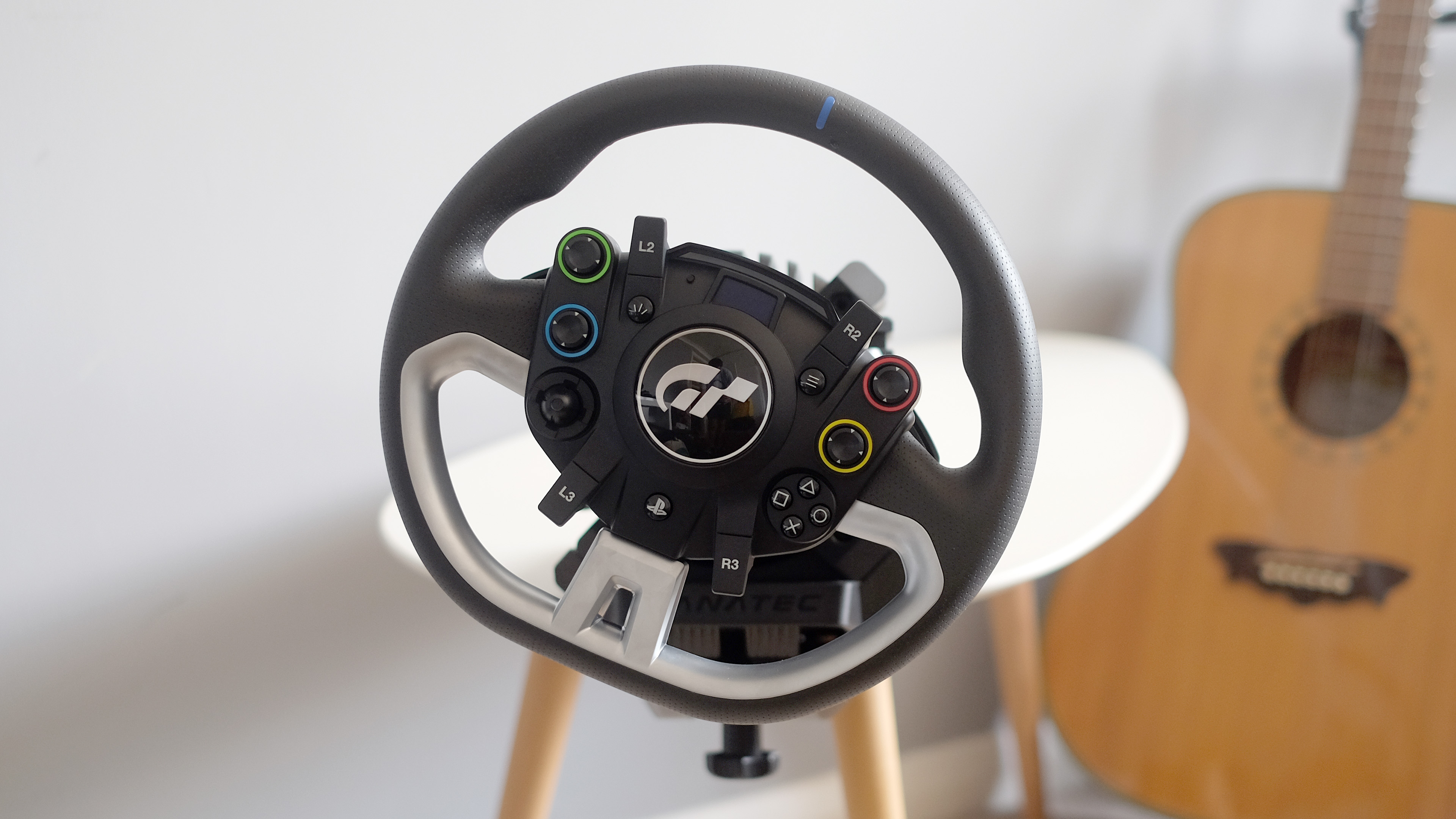Fanatec Gran Turismo DD Pro review: pure racing perfection
The Fanatec DD Pro is the official force feedback racing wheel for Gran Turismo 7. That status is proof of how brilliant, how revolutionary, this wheel set is.


A fantastic racing wheel that mows down most cheaper kits with the realism and immersion of its force feedback. Prepare your credit card: buying one risks serious damage to your bank balance through Fanatec’s many upgrade routes. If, that is, you can find one new, as these have been popular wheel sets.
-
+
Superb direct drive force feedback
-
+
Part of a comprehensively upgradable system
-
+
Better value than it may at first appear
-
+
Good pedal travel
-
-
Rubber-topped composite wheel not as luxurious as you might hope
-
-
Only includes a 2-pedal board
-
-
You could end up spending a small fortune on upgrades
Why you can trust T3

The Fanatec DD Pro is the official force feedback racing wheel for Gran Turismo 7. That status is proof of how brilliant, how revolutionary, this wheel set is.
Why? The Gran Turismo bods usually team up with Thrustmaster or Logitech for these official tie-ins. Fanatec is much more of a niche, enthusiast brand. You average Fortnite fan has probably heard of Logitech. But Fanatec? Maybe not.
Then there’s the price. The Fanatec Gran Turismo DD Pro is the “budget” force feedback wheel in Fanatec’s line-up, but it costs €699. That's more than a PlayStation 5.
That Fanatec makes this bundle seem worth the money, and more, is a big achievement in itself. This is the best pound-for-pound new force feedback racing wheel released in years.
Fanatec Gran Turismo DD Pro review: Force Feedback

Its special sauce is that corrugated brick at the centre. The DD Pro is the most important wheel base released in generations, but to explain why I’ll have to get a little bit nerdy before we get onto how nerdy tech results in pedal-to-the-metal fun.
The DD Pro block at the centre of the Fanatec Gran Turismo DD Pro is the first ever “affordable” direct drive wheel base. In any force feedback racing wheel, a motor adds resistance to your turns and, at times, does its best to wrench the steering wheel out of your hand.
In most models a series of belts or gears connect the motor bit to the actual steering wheel bit. The Fanatec Gran Turismo DD Pro is what’s known as a direct drive wheel, meaning the steering column is directly jammed into the motor itself.
Get all the latest news, reviews, deals and buying guides on gorgeous tech, home and active products from the T3 experts
This avoids several of the biggest complaints you can level at other racing wheels. The Fanatec Gran Turismo DD Pro doesn’t have the notchy feel of the geared Logitech G923. It doesn’t suffer from any belt slippage like the Thrustmaster T300 RS.
It’s ultra-smooth, and there are no obvious downsides to using a direct drive system other than price. The €349 price, which is what the base bit (the Xbox-only version, anyway) costs on its own, is damn cheap for a direct drive brain. Other models in the Fanatec range are a solid indicator of what you’d have to pay before this little thing arrived: the Fanatec Podium Wheel Base DD2 costs €1499 without any pedals or even an actual steering wheel.
The end result is force feedback that just feels more immediate, more refined and higher-fidelity than anything available near the cost. It blows rivals cheaper like the Thrustmaster T248 and Logitech G923 away, and is smoother than the Thrustmaster T-GT series. And, sure, some of those cost around half the price, but in some respects the Fanatec is more than twice as good.

Pair the Fanatec Gran Turismo DD Pro with Gran Turismo Sport or Gran Turismo 7 and that sense of “holy crap I’m driving a car” is immediate, and much more convincing than the other wheels I’ve reviewed recently. And Gran Turismo is hardly the peak of racing realism to start with, at least according to many sim racing nuts. The combo of fidelity, refinement and power here is truly brilliant.
That said, the Fanatec Gran Turismo DD Pro isn’t the most powerful force feedback I’ve used. It easily beats the Thrustmaster T248, roughly matches the Thrustmaster T-GT II, but isn’t close to the old discontinued monster Fanatec ClubSport v2.5.
It will give your arms a light workout, but can’t punish them like a sadistic personal trainer. Want pain? You can have it if you get the Boost Kit 180. This is a beefier power supply that almost doubles the strength of the force feedback. Fanatec sent me one to try out. Just like a maxed-out Fanatec ClubSport v2.5, it was a bit much for my weedy arms at maximum strength. Ok, so a lot much. Driving becomes a real struggle, just as Fanatic intends. However, one of the best aspects here is how upgradeable the Fanatec Gran Turismo DD Pro is, which becomes even more important when we look at some of the other areas.
Fanatec Gran Turismo DD Pro review: The wheel

The Fanatec Gran Turismo DD Pro’s steering wheel layout is similar to that of the Thrustmaster T-GT, a wheel made for Gran Turismo Sport a few years ago. Most of the inputs of a PlayStation pad are replicated, but see those sticks? They’re four-way directional controls, not free-wheeling analogue sticks.
You can tell Fanatec couldn’t afford to ship a truly luxurious steering wheel with the package, as it’s “entry-level” by the company’s usual standards, and not as flash as that of a Thrustmaster T-GT II. Its shell is plastic, or “composite” as Fanatec calls it. This stuff feels tough, but I’m used to seeing metal in wheels this pricey, and there’s almost none of that here.
The rim of the wheel is coated in rubber. It’s practical, but not as nice as the leather used in the much cheaper Logitech G923 or, again, the Thrustmaster T-GT series.
This is where we end up paying for the next-gen tech of the Fanatec Gran Turismo DD Pro’s “brain”. However, in practical terms it is perfectly solid. The rubber grip feels good and the rear shifters, while composite rather than aluminium or steel, are responsive and have just as robust clicky feedback as a higher-end steering wheel.

There’s also a neat little display embedded in the wheel’s centre. This lets you control key parameters like wheel sensitivity, force feedback strength and turning weight without having to rely on the options on offer in specific games. The display can also relay telemetry data. In the Gran Turismo games, for example, it shows your current speed.
The LED rev indicator might be more useful. This sits above the screen, turning from red to orange to blue across the LED strip as you reach each gear’s limit.
It’s a good steering wheel, but not quite a match for the metal brick base in terms of build. If you end up going deep down the sim racing rabbit hole, you can replace this wheel in future anyway, though. Fanatec produces a whole library of the things, as this is how you can also make the Fanatec Gran Turismo DD Pro work with an Xbox.
The standard kit works with PC, PS4 and PS5. Plug it into an Xbox Series X and it won’t be recognised. However, buy an additional Xbox-compatible wheel, slot it into the base and it’ll work just fine on an Xbox Series X.
This compatability stuff is annoying. It would, of course, be nice if these wheels worked with both console platforms, but you see the same issue across all force feedback racing wheels.
Fanatec Gran Turismo DD Pro review: The Pedals

The Fanatec Gran Turismo DD Pro’s pedals are also positioned as a sort-of starter set that you might want to upgrade in future. It’s a two-pedal board, where you’d normally expect to see a three-pedal set for this sort of money.
A clutch is the missing part. So, do you want one? I never use a manual clutch setting when playing racing games. I’m bad enough at racing without that added layer of complication.
You can add one in for €40, as this pedal board is made for easy customisation. An Allen key and a couple of minutes is all it takes to remove and add pedals, and there are pre-drilled for them across the board.
The pedals have greater travel than most, and the brake has a compressible bung inside the mechanism to get that sense of increasing resistance as you push the pedal down. Maximum resistance is still quite light for a racing wheel this serious, but that is not really a major negative point for anyone but the dedicated sim racer.
If you’ve already migrated from the likes of Gran Turismo to iRacing, though, you’ll probably want to buy a bundle with Fanatec’s superior ClubSport pedals, or the load cell brake upgrade. This is a separate pedal with a totally different feel to the bundled brake. It’s an order of magnitude stiffer, and the “load cell” bit means the sensor looks at how much pressure is applied, not how far the pedal is depressed. This upgrade is not for everyone. It is super-super stiff, and absolutely needs to be screwed into a solid wheel stand or chair.

Use the kit as-is and you get an excellent steel frame and super-accessible semi-realistic feeling pedals. It’s also emblematic of the way Fanatec often takes the completely inverse approach to Logitech and Thrustmaster. Where their pedals might use a reinforced plastic internal structure and metal pedal caps, here the inner workings are metal, the pedal caps are plastic.
I think the plastic is perfectly fine. It’s rigid enough, the convex shape feels good. But if that’s a turn-off Fanatec offers a set of metal caps for €35 (this includes a cap for the clutch, so you pay about a tenner each).
You’re probably getting the idea by now. Fanatec offers loads of ways to upgrade the Fanatec Gran Turismo DD Pro, including separate shifters and handbrakes not even mentioned yet. The amount you could end up spending is mildly terrifying. However, there’s really no need to for 95 per cent of folks.
The only part I demise is that the steering wheel’s outer doesn’t feel quite as plush as that of a Thrustmaster T-GT II or Logitech G923. However, perhaps not making dead animal skin the default covering is the right choice these days.
Fanatec Gran Turismo DD Pro review: Verdict

The Fanatec Gran Turismo DD Pro is the only racing wheel you’ll ever need, at least until a new console platform comes along that refuses to support it.
Its direct drive force feedback is sensational, offering fidelity and realism you just don’t get with the cheaper sets from Logitech and Thrustmaster.
There’s a catch. Prepare for upgrade-itis, because while the wheel base is terrific, Fanatec offers a host of ways to make this setup even better. Upgraded steering wheels, a force feedback power upgrade kit, more pedals, more advanced pedals, a handbrake. The list goes on. As does the price.
However, even with the included parts alone, Fanatec’s focus on the fundamentals leads to a racing experience that is purely mind-blowing.
Also Consider
Thrustmaster’s T-GT II is the closest price rival to the Fanatec Gran Turismo DD Pro. Its steering wheel is a bit fancier, thanks to its leather coating, and the pedal board has three pedals rather than Fanatec’s two. However, its force feedback isn’t as good as Fanatec’s. It is not as smooth or refined, even if it is just as powerful, presuming you don’t opt for Fanatec’s 180W boost kit. Thrustmaster offers attractive side dishes, but Fanatec’s main meal is more satisfying.
Cheaper Logitech and Thrustmaster wheels like the G923, T300 RS and T248 are, let’s be honest, probably more sensible buys for many folks. But they just don’t get close to the Fanatec for realism and fidelity. The best of the three for force feedback quality is probably the old Thrustmaster T300 RS, which holds up well today despite its age.

Andrew is a freelance tech and entertainment journalist. He writes for T3, Wired, Forbes, The Guardian, The Standard, TrustedReviews and Shortlist, among others.
Laptop and computing content is his specialism at T3, but he also regularly covers fitness tech, audio and mobile devices.
He began writing about tech full time in 2008, back when the Nintendo Wii was riding high and smartphones were still new.